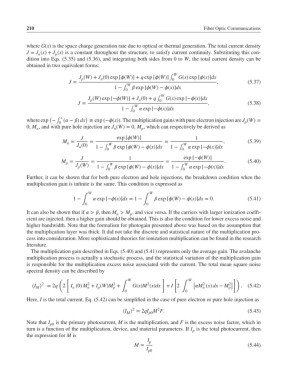Page 229 - Fiber Optic Communications Fund
P. 229
210 Fiber Optic Communications
where G(x) is the space charge generation rate due to optical or thermal generation. The total current density
J = J (x)+ J (x) is a constant throughout the structure, to satisfy current continuity. Substituting this con-
p
n
dition into Eqs. (5.35) and (5.36), and integrating both sides from 0 to W, the total current density can be
obtained in two equivalent forms:
J (W)+ J (0) exp [(W)] + q exp [(W)] ∫ W G(x) exp [(x)]dx
n
p
J = 0 , (5.37)
1 − ∫ W exp [(W)− (x)]dx
0
J (W) exp [−(W)] + J (0)+ q ∫ W G(x) exp [−(x)]dx
p
n
J = 0 , (5.38)
1 − ∫ W exp [−(x)]dx
0
( x )
where exp − ∫ ( − ) dx ≡ exp (−(x)). The multiplication gains with pure electron injection are J (W)=
0 p
0, M , and with pure hole injection are J (W)= 0, M , which can respectively be derived as
n n p
J exp [(W)] 1
M = = = , (5.39)
n W W
J (0)
n 1 − ∫ exp [(W)− (x)]dx 1 − ∫ exp [−(x)]dx
0 0
J 1 exp [−(W)]
M = = = . (5.40)
p
J (W) 1 − ∫ W exp [(W)− (x)]dx 1 − ∫ W exp [−(x)]dx
p
0 0
Further, it can be shown that for both pure electron and hole injections, the breakdown condition when the
multiplication gain is infinite is the same. This condition is expressed as
W W
1 − exp [−(x)]dx = 1 − exp [(W)− (x)]dx = 0. (5.41)
∫ ∫
0 0
It can also be shown that if > , then M > M , and vice versa. If the carriers with larger ionization coeffi-
n p
cient are injected, then a higher gain should be obtained. This is also the condition for lower excess noise and
higher bandwidth. Note that the formalism for photogain presented above was based on the assumption that
the multiplication layer was thick. It did not take the discrete and statistical nature of the multiplication pro-
cess into consideration. More sophisticated theories for ionization multiplication can be found in the research
literature.
The multiplication gain described in Eqs. (5.40) and (5.41) represents only the average gain. The avalanche
multiplication process is actually a stochastic process, and the statistical variation of the multiplication gain
is responsible for the multiplication excess noise associated with the current. The total mean square noise
spectral density can be described by
W W [ ]
( [ ] [ ])
2
2
2
2
2
⟨I ⟩ = 2q 2 I (0) M + I (W)M + G(x)M (x)dx + I 2 M (x) dx − M 2 . (5.42)
M n n p p ∫ ∫ n p
0 0
Here, I is the total current. Eq. (5.42) can be simplified in the case of pure electron or pure hole injection as
2
2
⟨I ⟩ = 2qI M F. (5.43)
M
p0
Note that I is the primary photocurrent, M is the multiplication, and F is the excess noise factor, which in
p0
turn is a function of the multiplication, device, and material parameters. If I is the total photocurrent, then
p
the expression for M is
I p
M = (5.44)
I p0

